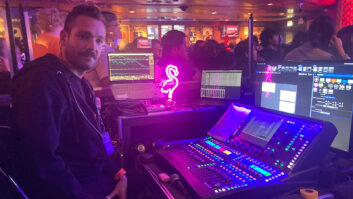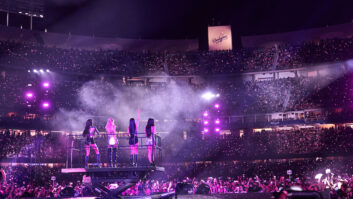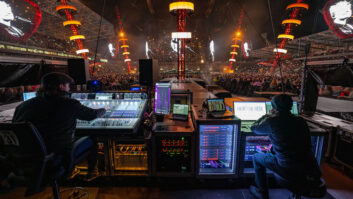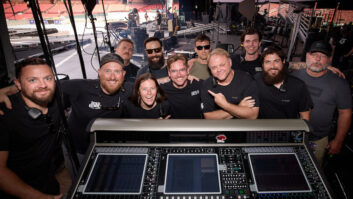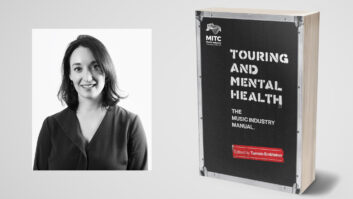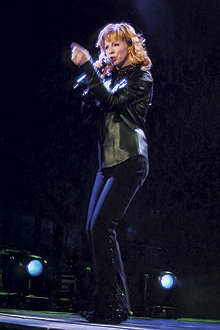
Country diva Reba McEntire
Other than being classified as country music artists, Reba McEntire and Brad Paisley don’t have much in common. One’s a deft guitar slinger, one’s an expert microphone wielder; one’s a glitzy, polished Broadway-esque diva, one’s an amped-up, dressed-down everyman. But in mid-April at Raleigh, N.C.’s Alltel Pavilion, one commonality was apparent: They share a ton of fans.
The audience’s enthusiasm and ceaselessly swaying bodies geared up during Paisley’s set and stayed put for McEntire, who closed the night with a well-choreographed production of spotless performances with the help of her backing band (Bruce Bouton, steel guitar; Spady Brannan, bass; Tommy Harden, drums; Jim Kimball, guitar/harmonica; Jerry McPherson, guitar; Jimmy Nichols, keyboards; Tammy Rogers, fiddle/mandolin; Doug Sisemore, keyboards; and Jennifer Wrinkle, guitar/fiddle).
MCENTIRELY REAL
McEntire’s show may be a perfected affair, but it’s 100 percent real, confirms her front-of-house engineer Ricky Moeller, who has worked with McEntire for more than 20 years. “It’s all about playing the music,” he says. “It’s like mixing a symphony: There are a lot of people onstage and it must be balanced.”

Paisley’s engineers: Kevin Freeman and Mark Gould
For Kevin Freeman, Paisley’s FOH engineer of six years, his gig is defined by Paisley’s onstage persona: He doesn’t tame the artist and his rollicking, crowd-enthralling band, but keeps them in check. “Instead of just letting them mix, I’m driving the faders all the time,” Freeman says. “They’re right up front and in-your-face for a country band.”
McEntire’s camp selected a Clair Bros. i4 line array. “We’re playing mostly sheds, and the i4 offers a lot of clarity and separation in the low-mids,” Moeller explains. “It’s very detailed. But until someone can design something better, my first choice will always be a PRISM system. The PRISM is a bit denser-sounding and a lot easier to set up and tear down, but it takes up sight lines.”

McEntire’s engineers: Ricky Moeller (L), Robert Kosloski
Moeller is using a Showco Showconsole at FOH. “I’ve used just about every one of them that they’ve made,” he boasts. “I like digital control but love the sound of analog. The Showconsole’s EQs, mic preamps and onboard compression sound great. I also have a couple of Summit Audio DCL-200s.” Moeller also considers the Clair I/O crossover management system crucial to his work: “I’d never leave home without it,” he says. “It gives you so much control that even inferior gear can be made to work optimally.”
Freeman is using a 48-channel Midas Heritage 2000, which he says offers superior sound and straightforward operation. “I used a Midas XL4 in the past,” he recalls. “I don’t need that much console. The older I get, the more simplistic I get. That’s probably why I haven’t delved off into digital [consoles]. I’d much rather concentrate on what my band is doing instead of technology.”
The rest of Freeman’s rig is similarly simple and includes varied Drawmer and dbx dynamic processors and several effects units. “I have a TC Electronic M5000 for vocals,” he explains. “There’s a wealth of clean, nice reverbs on there. For drum ‘verb, I use a Yamaha SPX-990 because it’s a little trashier. I just use Program One — ‘Large Hall’ — and adjust the length longer or shorter depending on the tempo of the song. It makes the snare sound incredible.” But in the end, “It’s not my job to make them sound good,” he insists. “It’s my job to keep them from sounding bad.”

Guitar-slingin’ Brad Paisley
ONSTAGE SETUP
Monitor engineer Robert Kosloskie — who has worked with McEntire for more than 20 years — helms a Midas XL4 console to mix the band’s Sennheiser G2 in-ear monitoring system, augmented by a few sidefills and a sub-bass cabinet for Harden and Brannan. “Generally, everyone wants a solid stereo mix,” Kosloskie says. “Most have everything, with themselves on top a little bit.” McEntire has a “straight-up” mix, with a slight boost for the rhythm section. “Establishing time and pitch are her main things. Sometimes in these big sheds, I have to take out little instruments for clarity.” Shure U4D beltpack/handheld wireless systems are used with a SM58 capsule for McEntire’s vocals. Other than drums and background vocals, fewer than average instrument mics reside onstage. “We use Shure Beta 98D/S on toms, an AKG C408 on floor tom and AKG C414s on overheads,” says Kosloskie. “Nearly everything else is direct. The band has many of their effects built into their rigs.”
Paisley’s band also relies on Shure in-ears — PSM 700 Series with Ultimate Ears UE5 custom earphones — while monitor engineer Mark Gould handles the mix via a Ramsa SX1 console. “I like the Ramsa,” explains Gould. “Brad likes a lot of warm tone, and the Ramsa offers that. After I started using it, he’s been very happy with his mixes.” As for Paisley’s mics, it’s all Shure: SM58 for lead vocals, SM58 and SM86 for background vocals, and KSM27, KSM44 and SM57 on his three-guitar amp configuration. “Brad’s very particular about what his guitar sounds like,” Freeman says, “but we ended up finding a great mic combination.”
FINAL ENCORE
So other than the packed venues and the musical variety, what’s the coolest aspect of mixing country music’s most prominent redhead? “Reba’s challenging,” Moeller replies. “She expects nothing but the best out of her audio team, and that’s what we give her. We try to maintain a high standard of audio reproduction no matter what kind of environment we find ourselves in.”
Strother Bullins is a North Carolina — based freelance writer.



